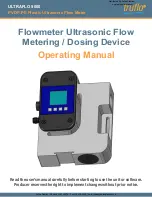
DESIGNER’S HANDBOOK 4189350049C EN
Page 74 of 206
In a single potentiometer application, for example when a potentiometer is used for rudder angle measurement.
It is possible to detect if a connection to the potentiometer is lost, it just requires that 0V is not part of the valid
measuring range.
If the complete rotation angle of the potentiometer is needed in the system, it is possible to obtain the above by
adding 2 extra resistors as shown below.
The input voltage from 0.83V to 9.17V shall be scaled to -45 to +45 degrees and the input error detection low level
can for example be setup to 0.5V (500mV) and the high error levels can be 9.3V. If any single connection is now
lost the input voltage will either be 0V or somewhere between 9.5 and 9.9V.
This is due to the 112k
Ω input resistance, in worst case when the 0V connection to the potentiometer is lost the
input voltage will raise to 9.53V and activate the input max error detection above 9.3V.
Worst case calculation if 0V connection is lost:
V error max, o =10V(source)*112k
Ω/(112kΩ+5kΩ+500Ω)= 9.53V so, the max. error value shall be between this
value and 9.17 that is the max. valid value, therefore 9.3V seems to be a good choice.
If it is a rudder application where the full potentiometer rotation angle is not used it may not be necessary to add
extra resistors to be able to make the detection of lost connection as long as the used voltage level leaves enough
extra voltage range to be able to detect that an input is lost, exactly the same way as in the above example.
The shown external resistors will in that case just be part of the internal potentiometer resistance.
Error detection on a potentiometer connected to Vref
When you use the build in Vref output to stabilize the measurement from a potentiometer, you must be aware that
the input voltage is measured as a relative value to Vref. 0V=0 and Vref=10 000.
















































